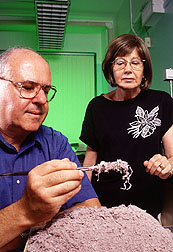This page has been archived and is being provided for reference purposes only. The page is no longer being updated, and therefore, links on the page may be invalid.
USDA Scientists Turn Hide-Tanning Waste into High-Value ProductsBy Doris StanleyNovember 23, 1998 WASHINGTON, Nov. 23, 1998--Using a common laundry detergent enzyme, U.S. Department of Agriculture researchers are turning shavings from cattle hide tanning into a high-value protein that can be used in a range of products, such as adhesives and packaging films, Agriculture Secretary Dan Glickman announced today. “This is an innovative process that puts to good use a waste product that now must be hauled off to landfills at a price,” Glickman said. “It is a discovery that is good for our environment and our economy.” From 100 pounds of cattle hides, a tanner gets only 50 pounds of leather--and 50 pounds of waste. Tanners use non-toxic chromium-III sulfate in tanning hides into leather. Then they shave the bottom sides of chromium-tanned hides to give them a uniform thickness. Each year, about 60,000 metric tons of shavings end up as waste bound for landfills. Agricultural Research Service chemists Maryann Taylor, Eleanor Brown and William Marmer were able to break down the chrome shavings with alkaline protease, an enzyme from a common laundry detergent. The researchers’ first product was a low-value protein hydrolysate that can be used in fertilizer. By modifying the process, they produced a high-value grade of gelatin protein that is ideal for making adhesives, industrial films for packaging, and encapsulating agents for industrial and agricultural chemicals. The higher-grade product is equal--and, in some cases, superior--to commercially produced gelatins. The scientists have been granted two patents for their research. Taylor also purified the chromium left over after the proteins were removed and reused it as an agent in the tanning process. The quality of leather produced was comparable to that of commercially tanned leather. She even found a way to recycle the enzyme used to liberate the proteins. ARS, USDA’s chief research agency, operates a pilot tanning plant, the only public facility of its kind in the United States, at its Eastern Regional Research Center in Wyndmoor, Pa. Scientists from Spain collaborated on part of the research. A modified version of the process is now being used in a tannery in the Czech Republic. ARS has also signed a cooperative agreement with ATO-DLO, a Dutch institution, to develop applications for the protein products. More information about the research is available on the World Wide Web at: /is/AR/archive/nov98/tan1198.htm Scientific contact: The scientists at the Hides, Lipids, and Wool Research Unit, Eastern Regional Research Center, Wyndmoor, Pa. William N. Marmer, phone (215) 233-6585, wmarmer@arserrc.gov; Maryann M. Taylor, phone (215) 233-6435, mtaylor@arserrc.gov; Eleanor M. Brown, phone (215) 233-6481, ebrown@arserrc.gov |

